NGC 7000 - North American Nebula
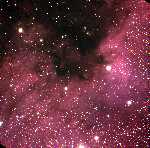 |
| Imax=0.7 |
ST-4000XCM, 3900s total exposure 9/13/12 Lake San Antonio, CA
This was our first photograph at Calstar taken with the new camera. It was almost straight overhead, in ideal position, and we gave it more than an hour of exposure. Usually the North American Nebula is imaged with a wide field setup to show its full extent and its position alongside the Pelican Nebula. However there are many fine details that can be seen with higher magnification, such as the small reflection nebula near the top of this image. Visually, this is a challenging object, but a faint glow can be made out.
NGC 6960 - Veil Nebula (west half)
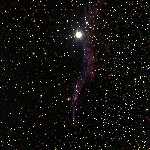 |
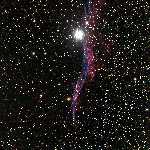 |
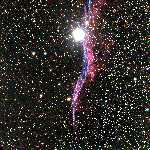 |
| Imax=2 | Imax=1 | Imax=0.5 |
ST-4000XCM, 1800s total exposure 9/13/12 Lake San Antonio, CA
Obtaining good-quality images of the Veil Nebula has been an ongoing project, but the images shown here are the best so far. Even with the larger area CCD, we can only image part of it in a single exposure. The portion shown here includes the bright star 52 Cygni.
NGC 6992/5 - Veil Nebula (east half)
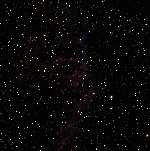 |
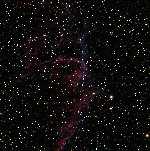 |
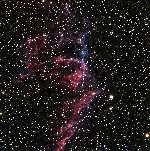 |
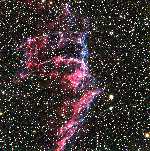 |
| Imax=5 | Imax=2.5 | Imax=1 | Imax=0.5 |
ST-4000XCM, 1800s total exposure 9/13/12 Lake San Antonio, CA
Here is another portion with a more complicated structure.
M33 - Triangulum Galaxy
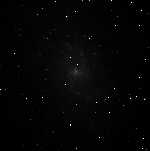 |
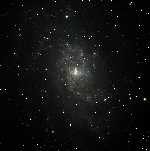 |
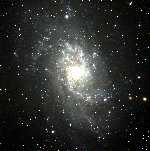 |
| Imax=12 | Imax=3 | Imax=1 |
ST-4000XCM, 2400s total exposure 9/13/12 Lake San Antonio, CA
At a distance of 3 million light years, M33 is one of the nearest galaxies, about the same distance as Andromeda. It is, in my opinion, the most spectacular of all the galaxies for imaging, since it is possible to resolve a large number of individual stars and nebulae. There are globular clusters in the image as well, though it is not obvious how to distinguish them from stars. The brightest emission nebula, appearing at about the 4:30 position relative to the center, is NGC 604.
B72 - Snake Nebula
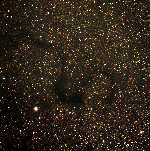 |
| Imax=1.5 |
ST-4000XCM, 1800s total exposure 9/14/12 Lake San Antonio, CA
This is another dark nebula that can be seen against the dense stars of the Milky Way in the southern part of Ophiuchus. It was rather low in the sky.
IC 348
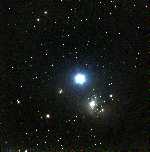 |
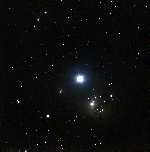 |
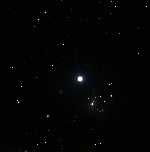 |
| Imax=1 | Imax=2 | Imax=7 |
ST-4000XCM, 1500s total exposure 9/14/12 Lake San Antonio, CA
This is a nice little reflection nebula near ο Persei.
NGC 1499 - California Nebula
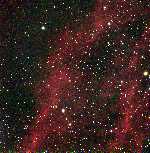 |
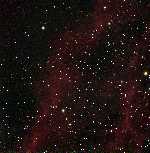 |
| Imax=0.5 | Imax=1 |
ST-4000XCM, 1500s total exposure 9/14/12 Lake San Antonio, CA
This image shows just a small portion of a diffuse nebula in Perseus whose shape, as seen in wide-angle photographs, vaguely resembles the outline of California.
NGC 2023 / IC 434 / B33 (Horsehead Nebula)
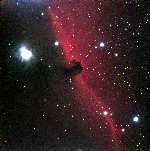 |
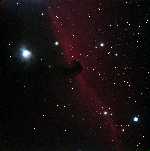 |
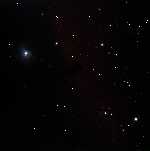 |
| Imax=0.8 | Imax=2 | Imax=8 |
ST-4000XCM, 1177s total exposure 9/14/12 Lake San Antonio, CA
I have been wanting for years to capture the Horsehead, but because Orion rises late at Calstar, this famous object has so far eluded us. This time, even though we were having battery problems, we saved our spare battery for the Horsehead, and were able to get about 20 minutes of exposure on it. The bright reflection nebula at left is NGC 2023, the Horsehead is B33, and the emission nebula associated with it is IC 434. Visually, I might have been able to detect something dark are the right location using averted vision, without using filters. I also tried an H-Beta filter I picked up at a recent swap meet, but the results were disappointing - I could not really see anything with it.
NGC 4319 and Quasar Markarian 205
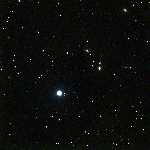 |
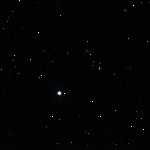 |
 |
| Imax=1.5 | Imax=7 | labeled |
ST-4000XCM, 1200s total exposure 9/15/12 Lake San Antonio, CA
This was our first effort to image a quasar, Markarian 205 in Draco, next to NGC 4319. The image on the right has them labeled. The prevailing view is that NGC 4319 is in the foreground (92 million light years away) while Markarian 205 is far behind it, about 1 billion light years from us, based on its redshift. However, opponents of the big bang theory have argued that some photographs have shown a faint bridge connecting the two objects, and thus they should be at the same distance, despite their different redshifts. In our image, while the quasar appears bright, the resolution and exposure depth would not be sufficient to distinguish it from a foreground star.
NGC 6905 - Blue Flash Nebula
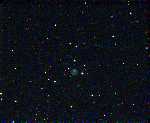 |
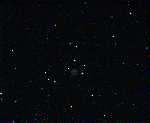 |
| Imax=150 | Imax=300 |
Starshoot DSCI, 1200s total exposure 9/15/12 Lake San Antonio, CA
This is a fairly bright planetary nebula in Delphinus that Kathy picked. It was not difficult to find visually. We went back to the old unguided imaging method, using only 5 second exposures for the best resolution. However, the exposures may have been a bit too short in this case.
NGC 1300
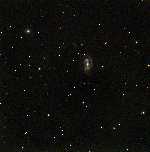 |
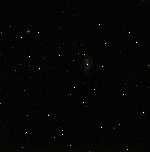 |
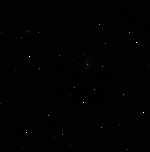 |
| Imax=1 | Imax=3 | Imax=10 |
ST-4000XCM, 1800s total exposure 9/15/12 Lake San Antonio, CA
This galaxy in Eridanus has a striking barred structure. It was rather low in the sky, so that the increased sky glow and possibly reduced transparency were factors. We wanted to take more exposures but ran out of battery power.